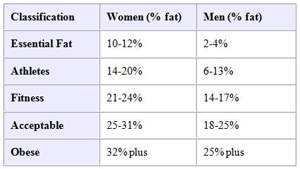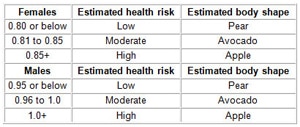Whether you’re trying to maintain your weight or lose a few extra pounds, there are several body measurement tools that can help you achieve your health and physique goals. These tools are also helpful for tracking change and progress, making it easier to identify “what’s working” or “what’s not” in your diet and fitness plan.
 Body Mass Index (BMI). BMI is a number calculated from an individual’s weight and height, used to estimate body fat. It’s an inexpensive and easy-to-perform method, often used as a screening tool for weight issues that could potentially lead to health problems. Note that having a high BMI doesn’t always mean you’re at risk for health problems. BMI does not take into account muscle mass “”so if you have a muscular physique, you could mistakenly fall into the overweight category. For this reason, I recommend using BMI along with one of the following two tools.
Body Mass Index (BMI). BMI is a number calculated from an individual’s weight and height, used to estimate body fat. It’s an inexpensive and easy-to-perform method, often used as a screening tool for weight issues that could potentially lead to health problems. Note that having a high BMI doesn’t always mean you’re at risk for health problems. BMI does not take into account muscle mass “”so if you have a muscular physique, you could mistakenly fall into the overweight category. For this reason, I recommend using BMI along with one of the following two tools.

Skinfold Assessment. For a more accurate assessment of body fat, you can use a tool such as the Sequoia Fitness MetaCal Body Fat Caliper to determine your body fat percentage. This simple test involves pinching the skin in specific areas to measure the thickness of the skinfold. The thickness indicates the amount of fat underneath the skin.It’s a good idea to know your body fat percentage when setting weight-loss goals, and to test it regularly to determine whether or not your plan is working. Use the Body Fat Percentage Chart (right) as a guide.
Waist-to-Hip Ratio (WHR). The WHR is a simple way to measure body fat distribution. It’s considered a good indicator of health risks associated with central obesity. To determine your WHR, use a measuring tape such as the AccuFitness Myo Tape.

When measuring, your waist is the smallest circumference between the rib cage and belly-button, and your hip circumference is the largest part of the hip-buttocks area. Divide your waist measurement in inches by your hip measurement in inches (for example: 34-inch waist/40-inch hips), or use a WHR calculating tool. After determining your ratio, use the Waist-to-Hip Ratio table (left) to find your body type.
Southern States Championships top contender Melissa Transou, a figure competitor, wife and mother, blogs about the unique sports nutrition needs of female athletes exclusively for Vitacost.com.
